Can You Lift Weights After Knee Replacement Surgery? Yes, Here’s How
Updated 7/7/24
Going through a knee replacement can be very scary for anyone who’s physically active.
Trust me, I know I was so nervous before my knee replacement surgery.
I had so many questions.
Will I still be able to do the things I love, like weightlifting, after the surgery?
After talking to my surgeon, I found out that this was a very common question for active people thinking about having a knee replacement.
He told me that lifting weights after surgery is not only possible but encouraged for most people because it can help build strength and speed up recovery.
However, it would take some time and hard work to get back there.
So, let’s explore weightlifting after knee replacement surgery, and I’ll provide some tips and advice for anyone looking to get back into the gym.
Benefits from Weightlifting After a Total Knee Replacement
Lifting weights after a knee replacement offers several benefits like:
- Improves your balance and coordination.
- Improving your knee function
- Decreases pain and inflammation in the knee.
- It builds muscle mass and strength in the muscles that support the knee.
- Weightlifting is a low-impact exercise, which makes it safe after a knee replacement.
- It also helps mentally by releasing endorphins that help you feel relaxed and happy.
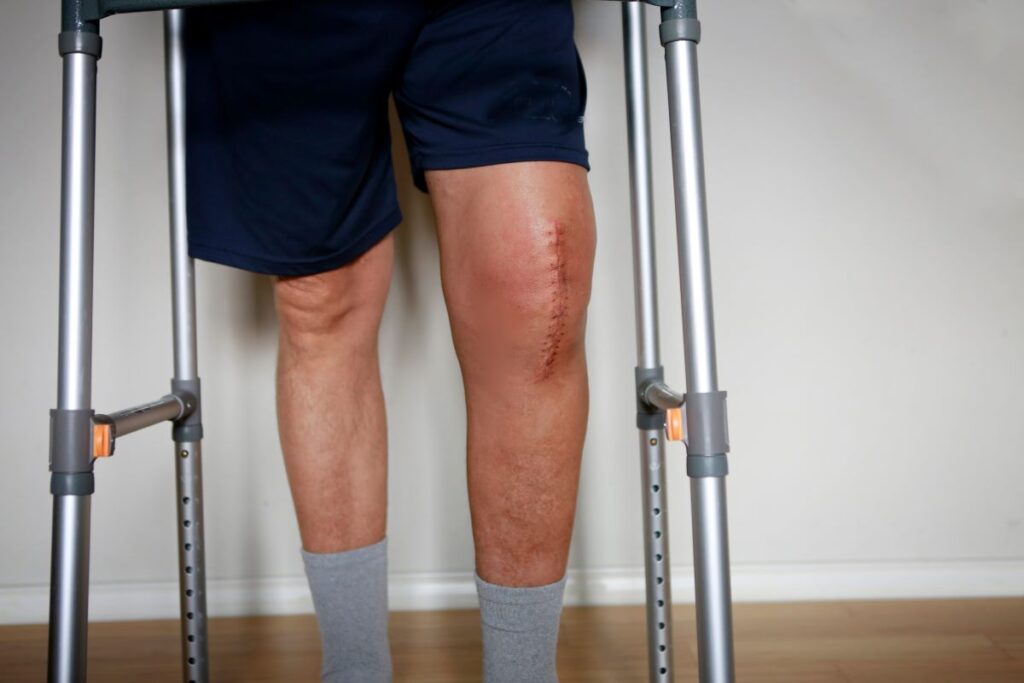
Weightlifting After Knee Replacement
This is when the real work or fun begins.
For me, it was the best day ever! Just getting back to my weight room was indescribable.
Even though you are feeling better and maybe, like me, excited about getting back to lifting – don’t push it too hard.
If you do too many reps or too heavy of weights or resistance bands, you could compromise your form. This could cause injury to your new knee or other parts of your body,
So, start slow!
This will be a marathon, not a sprint!
When to Start Weightlifting
After knee replacement surgery, be sure to give your body time to heal.
For the first few weeks, it’s best to rest with your leg elevated and an ice pack on it to decrease your swelling.
You will only be able to walk short distances with an assistive device like a walker or crutches for the first couple of weeks.
Some people may need it longer.
Physical therapy will begin right away (mine started the next morning after my knee surgery).
You will just start with some stretching and range of motion exercises to get your knee moving – this will kick your ass!
My physical therapist started me with some very light weights and resistance exercises with a resistance band as well as a stationary bike around 3-4 weeks post op.
After 6 weeks my physical therapy was stopped and I then started doing weightlifting exercises at home – I did talk to my physical therapist about returning to weightlifting and she was able to give some guidance with this.
Just be smart, listen to your doctor and do not rush into weightlifting too soon, this can cause damage to your new knee and delay healing.
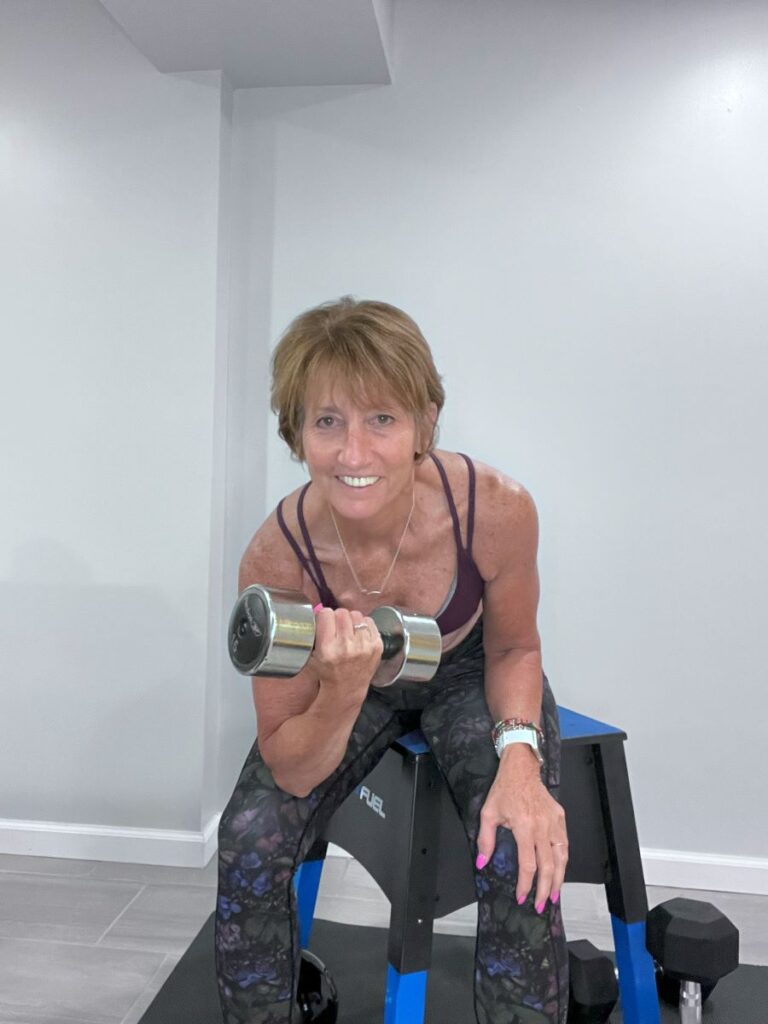
How to Increase Your Weights
I started out very light for leg exercises – trust me light feels heavy those first few months!
I was able to do upper-body exercises with heavier weights while sitting on my weight bench. Remember, any weight, while standing, will put more pressure on the leg.
The best place to start a weightlifting program is to build on where you left off with your therapist.
If you were doing 6 squats or step-ups with a 2-pound weight at therapy, try increasing to 7 squats or step-ups with the 2-pound weight.
If you were doing lateral walks or leg lifts with a medium resistance band, increase the number of steps or lifts first with the medium resistance band.
When you can do 12-15 reps without any increased pain, swelling, or compromising of your form, then you can slowly increase your weights or resistance.
However, when you do increase your weights, you will want to return to lower reps and build up again.
The key is to change up your reps first and then, when you are ready increase your weights.
If you feel lost because you are new to weightlifting or if you are scared that you may injure yourself, it may be best to work with an athletic trainer for a month or two after your discharge from therapy.
They can show you how to properly use resistance bands, free weights, and nautilus equipment. Most gyms have trainers you can talk to.
It will take some time to get back to where you were. Probably around 6-12 months. That’s okay. Don’t push it, you will be there before you know it – without new pains or injuries.
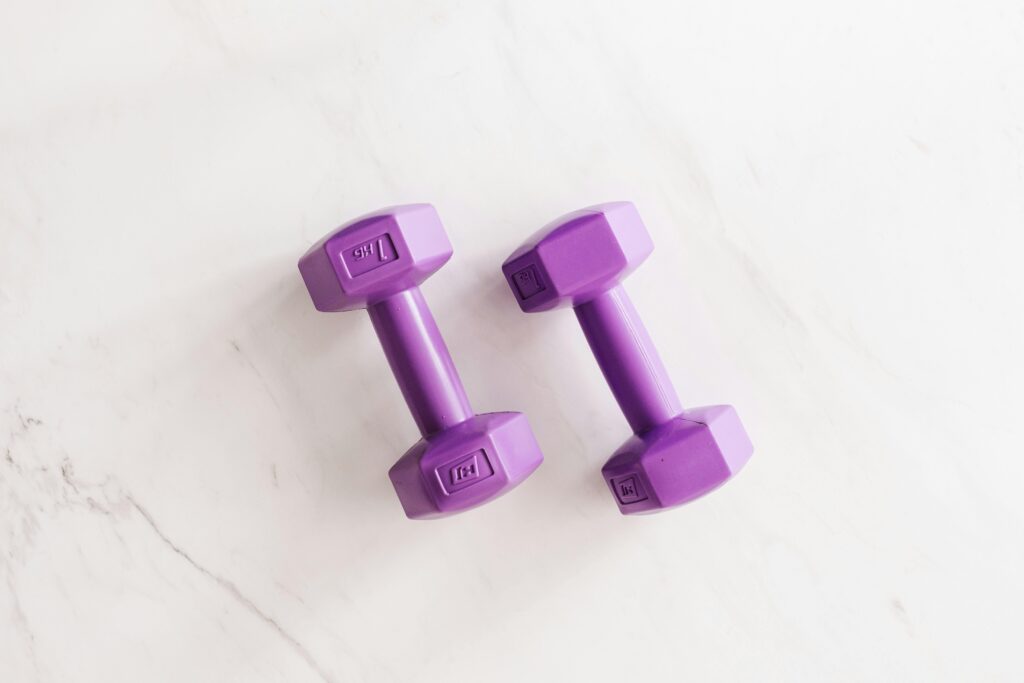
Safe Weightlifting Techniques
Always be sure to use safe techniques when you get back or start weightlifting.
Make sure that you are using proper form and posture when lifting weights – back straight, knees slightly bent.
It’s also important to start with light weights and gradually increase the weight as your strength improves.
Avoid some exercises that put too much strain on your knee joint. This includes exercises such as deep squats, heavy forward lunges, and drop squats.
My doctor told me that I should not ever, even after a full recovery, return to doing deep squats or drops squats because they could damage my new knee. I have however, returned to heavy forward squats without any issues.
Best Exercises to do with Weights After Knee Replacement
The following exercises are a few that my physical therapist encouraged me to do to build up my leg muscles after my joint replacement surgery.
These strength exercises will put strain on your new knee joint so be safe and begin each one with just bodyweight at first. As you get stronger then you can add reps and weights.
1. Reverse Lunges
Reverse lunges are great for working on leg strength and balance.
Here’s how to do them:
- Stand with your feet hip-width apart and your hands on your hips.
- Step back with your right foot and bend your left knee, keeping your back straight.
- Hold the position for a few seconds, then return to the starting position.
- Repeat on the other side.
READ MORE: Best Modified Lunges For Seniors: Easy Exercises To Stay Active | Simply Aging Healthy
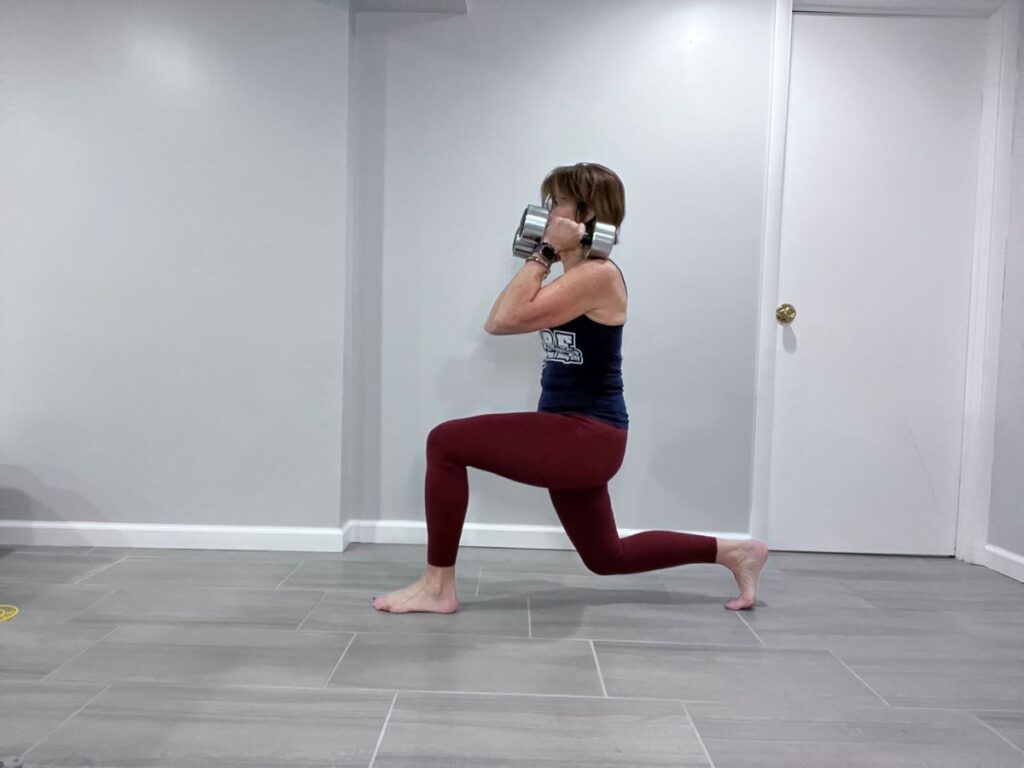
2. Lateral Lunges
Start with only body weight until your leg is strong enough. When you feel stable while doing this exercise then go ahead a grab a light weight.
To perform them:
- Stand with your feet shoulder-width apart.
- Step to the right with your right foot.
- Bend your right knee, pushing your hips back.
- Keep your left leg straight.
- Return to the starting position and repeat on the other side.
READ MORE: Side Leg Exercises: Benefits And How To Tips For Seniors | Simply Aging Healthy
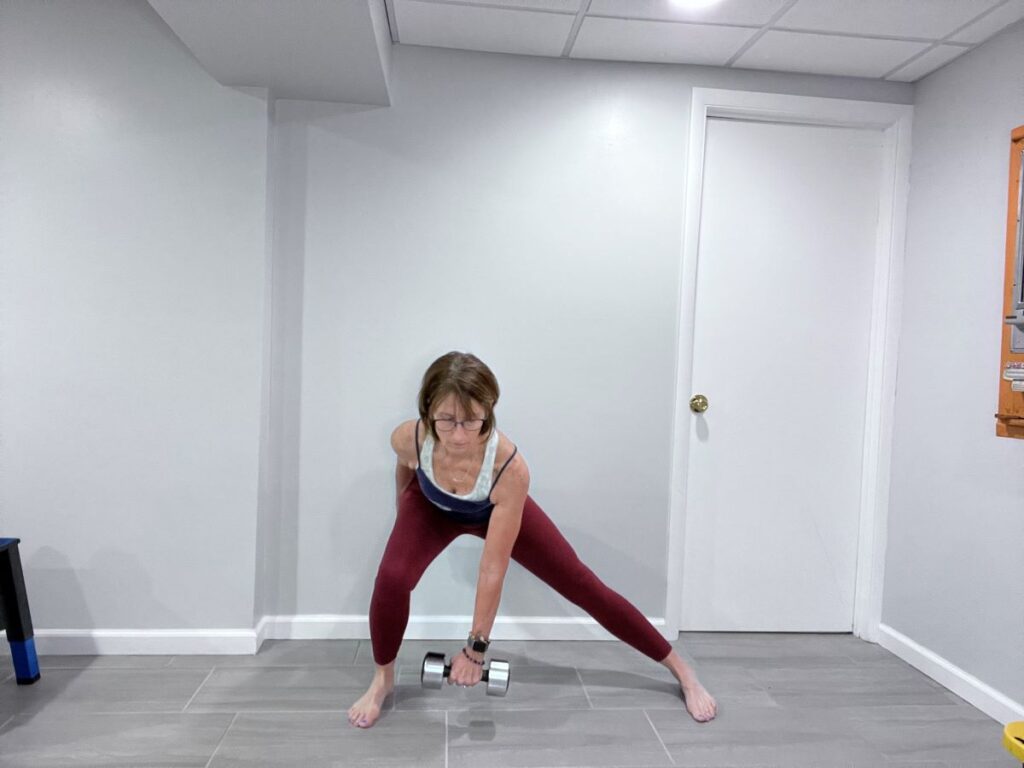
3. Goblet Squats
I started bodyweight squats while I was in physical therapy.
So, they were easier to stick into my resistance training
To do these:
- Start with weight in both hands in front of you at your chest.
- Stand with your feet shoulder-width apart.
- Lower your body as if you were sitting back on a chair.
- Keep your chest up and your knees over your toes.
- Push through your heels to stand back up.
READ MORE: 7 Easy Squats For Aging Knees: Tips And Techniques | Simply Aging Healthy
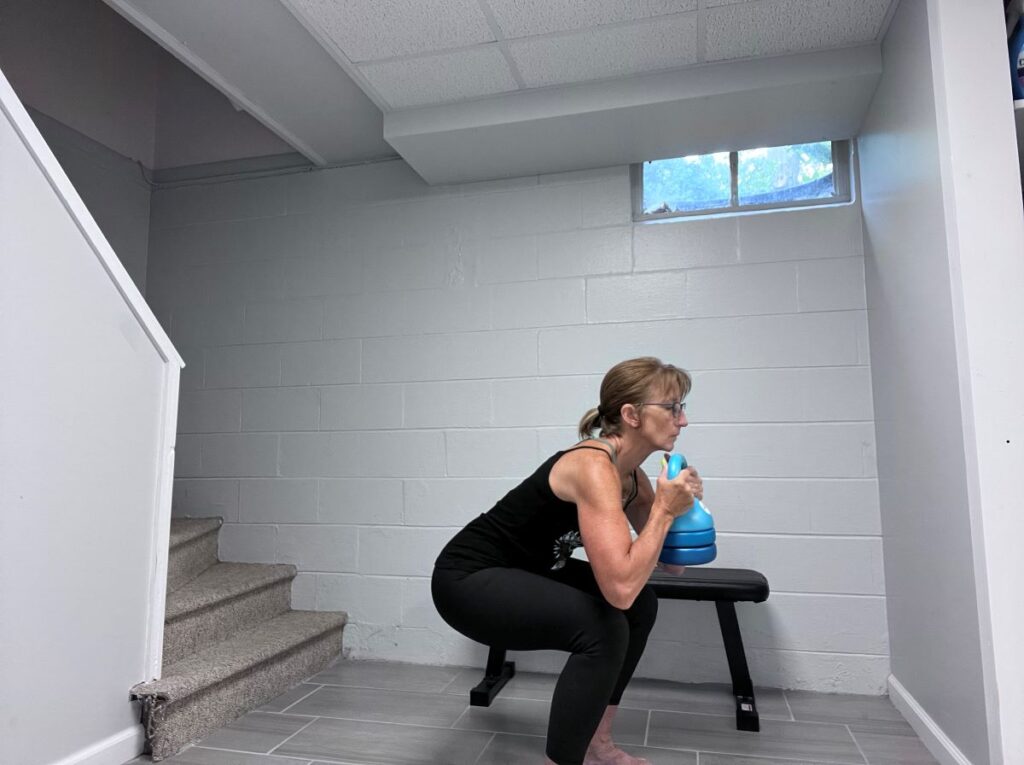
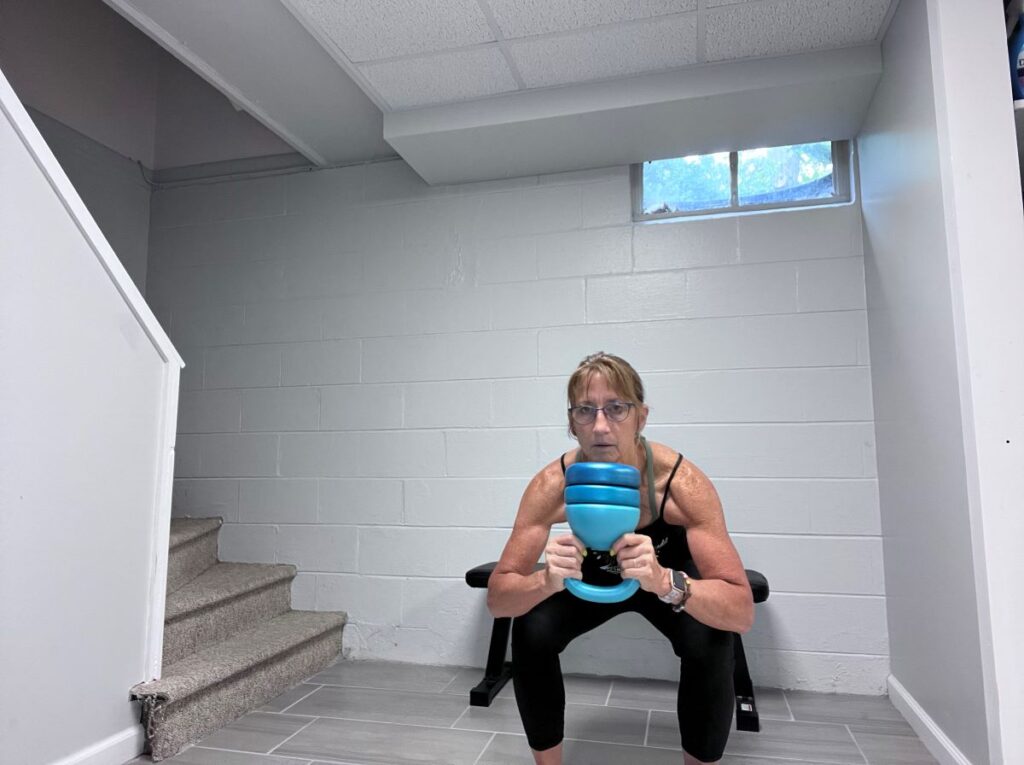
4. Step-ups
Start with bodyweight first with a low chair or step.
Then, when you are ready and feel comfortable, add some ankle weights or a light free weight – like 5 pounds and maybe increase the height of the step or stool.
- Place one foot on a stable step such as a bench, box, or chair.
- Begin standing on the box with one foot while slowly pulling the other leg up to the bench, box, or chair.
- Then, slowly lower the moving leg back down with control.
- Place both feet back on the floor and place the opposite foot on the box or bench, and repeat.
READ MORE: Best Alternatives To Step Ups: Simple Exercises For Older Adults | Simply Aging Healthy
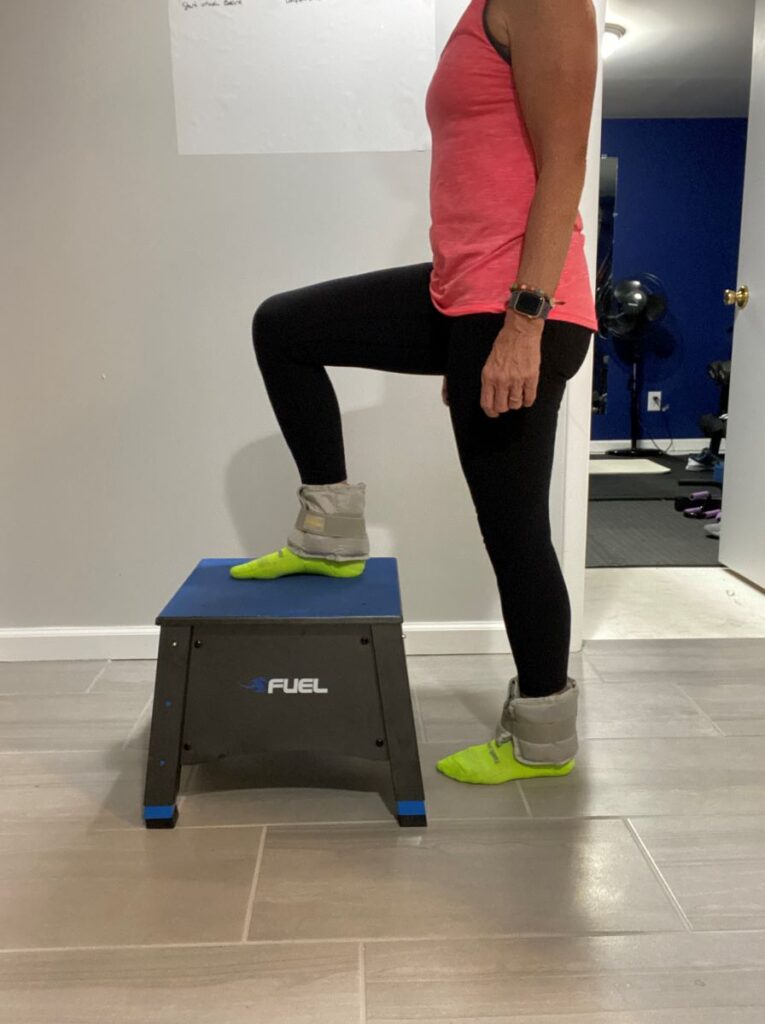
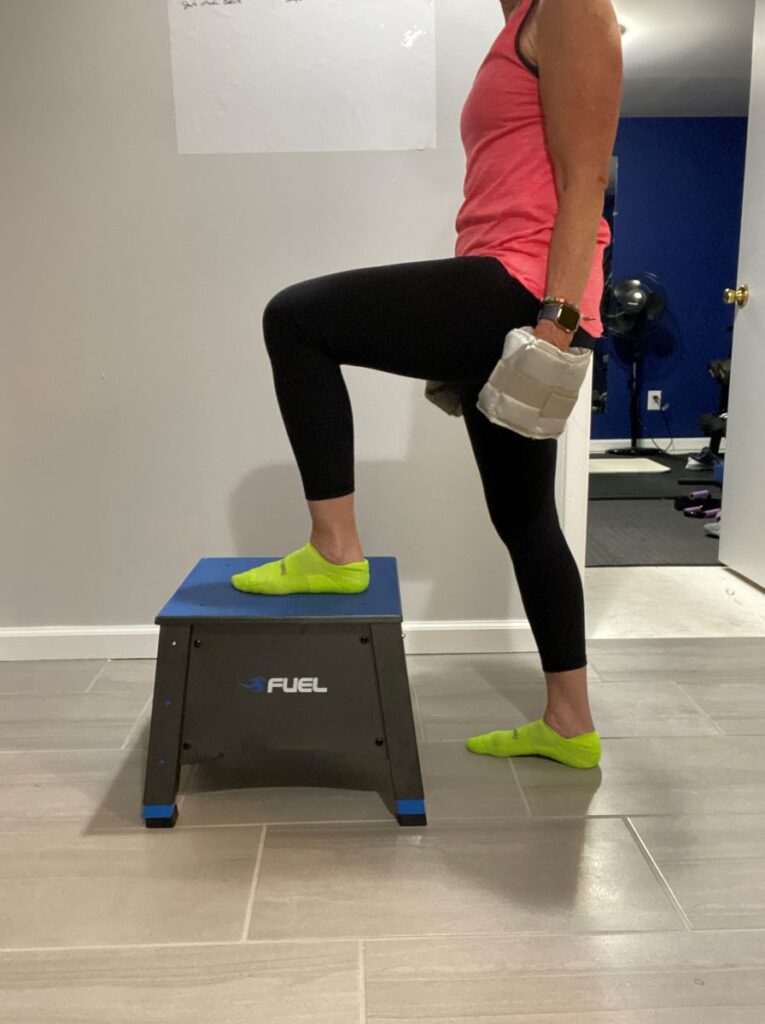
5. Romanian Dead Lifts
Start this one with both legs on the ground and only body weight.
When you are ready to move forward, grab a light weight. After you are comfortable and have more stability in your new knee then you can try single leg lifts.
To do a Romanian deadlift:
- Stand with your feet shoulder-width apart, holding a barbell or a dumbbell in each hand.
- Bend your knees slightly and push your hips back as you slowly bend forward, keeping your shoulders back and your back straight.
- Lift the left leg off the ground with the back heel facing the ceiling.
- Then keep your butt tight as you stand back up.
- Don’t hyperextend at the top, keep back straight.
- Then, lower back down with left leg raised.
- Repeat for 10-15 reps.
- Then, switch and lift the right leg.
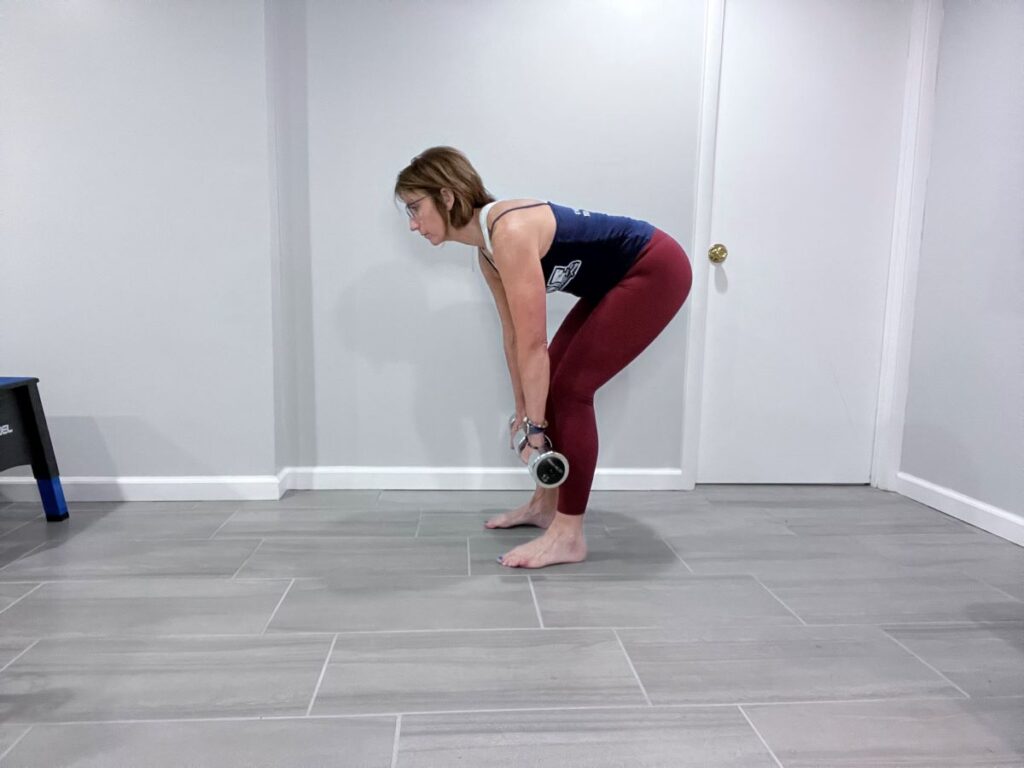
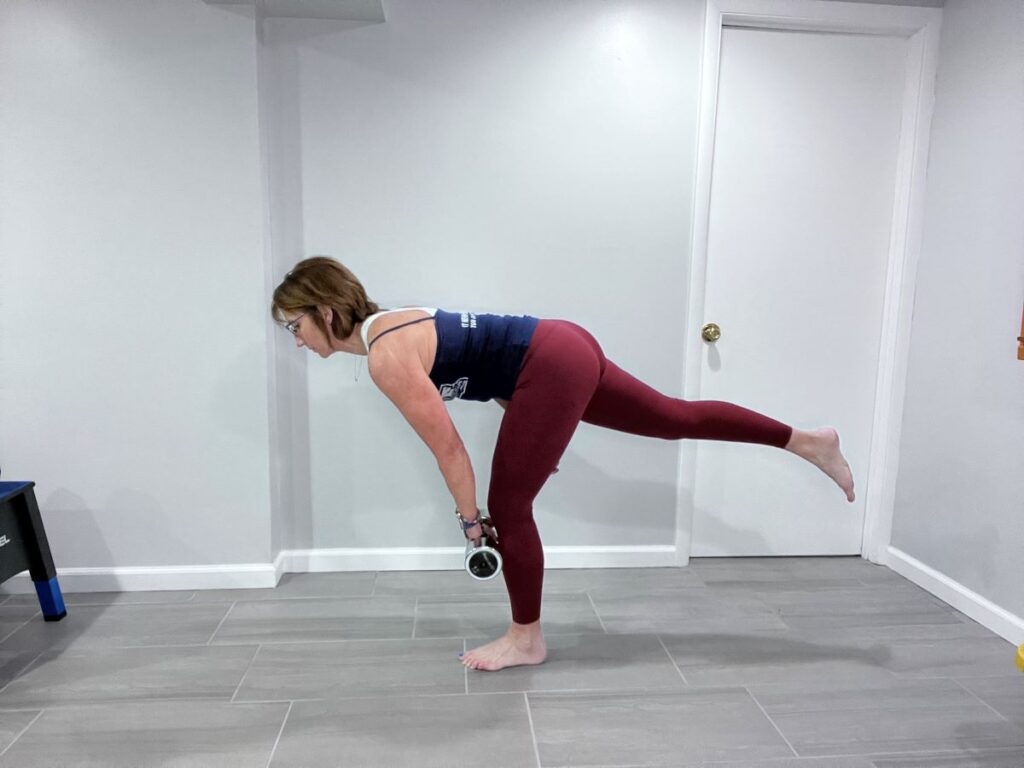
6. Calf Raises
To do calf raises to strengthen calf muscles:
- Stand with your feet shoulder-width apart.
- Lift your heels off the ground.
- Lower your heels back down.
- Repeat for several reps.
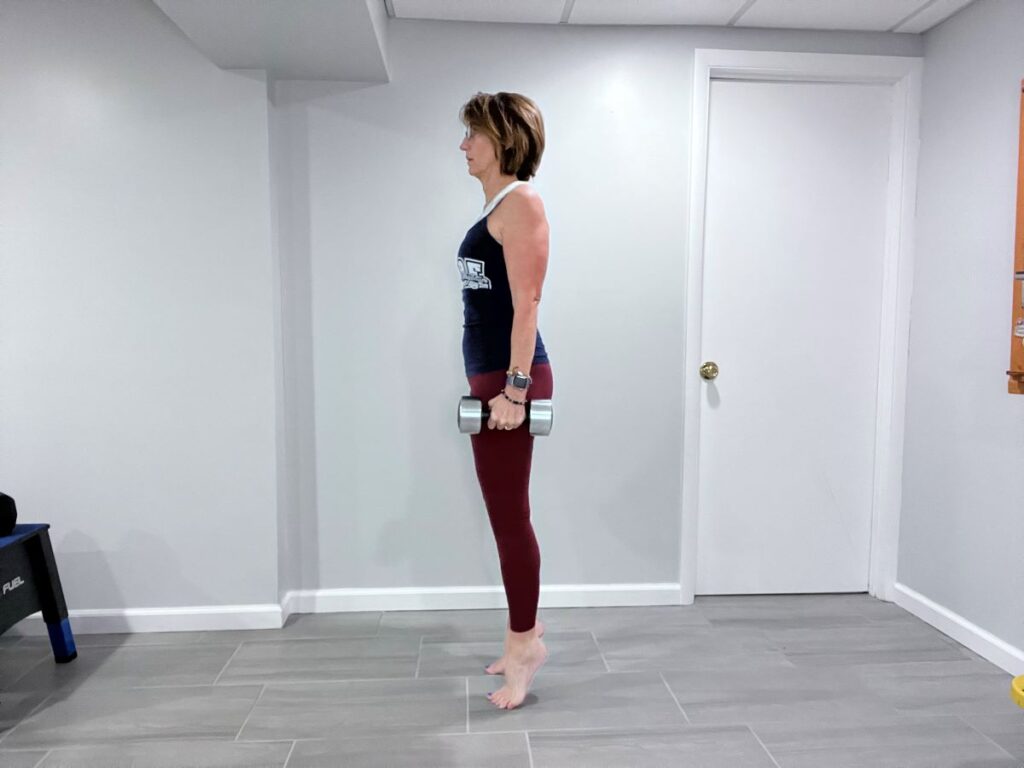
7. Wall Squats
I did start these while I was in physical therapy without a weight. I was then instructed to use a stability ball.
I was able to advance to placing a weight in my lap pretty quickly since you are supported by the wall and using both legs.
To do a wall sit:
- Stand with your back flat against a wall.
- Lower your hips down until your thighs are parallel to the ground.
- Hold this position for as long as you can.
- Keep your back flat against the wall while squatting.
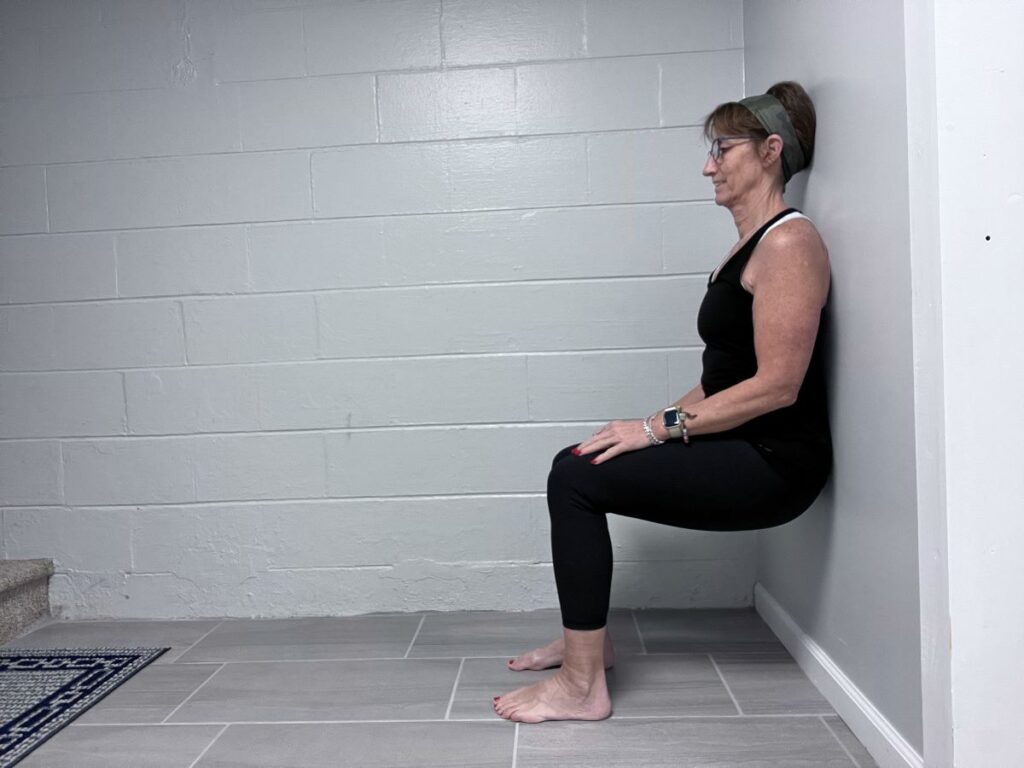
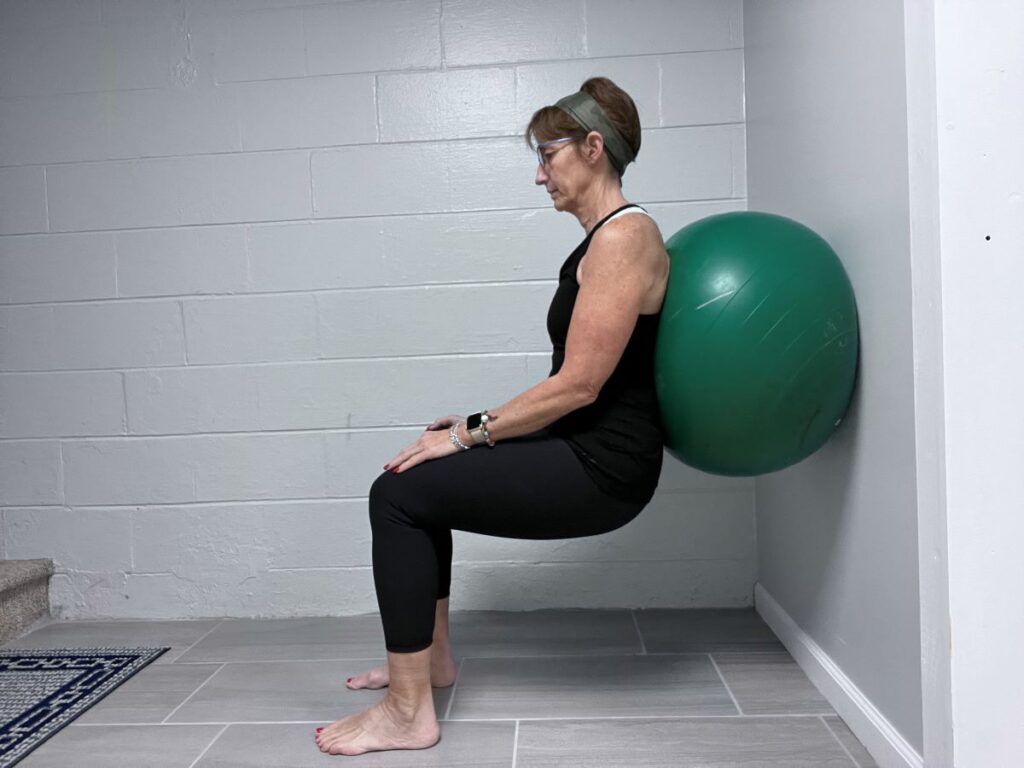
Listen to Your Body
As with all exercise programs, it’s important to listen to your body after knee replacement surgery.
Here are some tips to help you identify pain versus discomfort.
Identifying Pain vs. Discomfort
Trust me, you will have some discomfort when you return to your workout routine after knee replacement surgery, but it’s important to know if it is discomfort or pain.
Discomfort can feel achy or stiff but pain is sharp and intense. If you have any pain during or after your workout, you need to stop and rest.
If the knee pain persists, it would be a good idea to get some medical advice from your healthcare provider.
Adjust Workouts
If you notice pain or discomfort during your workout, you will need to adjust your routine.
This could mean decreasing the weight or resistance you use, modify the range of motion, or taking more or longer breaks.
You should also include several different exercises into your routine so that you don’t overwork one muscle group. This can help prevent muscle imbalances and reduce the risk of injury.
Remember, it’s better to take it slow and steady than to push yourself too hard and cause injury.
Yes, You Can Lift Weights After Knee Replacement
You absolutely can lift weights after total knee replacement surgery.
Don’t let the fear hold you back!
Lifting weights can help strengthen your muscles, improve your overall fitness, and improve your quality of life.
Whether you’re a health enthusiast or a senior looking to stay fit, including weightlifting into your routine can be a game-changer.
So, grab those dumbbells, or resistance bands, and get ready to enjoy the benefits of a stronger, healthier you!
Let me hear about your return to fitness after your knee replacement!
